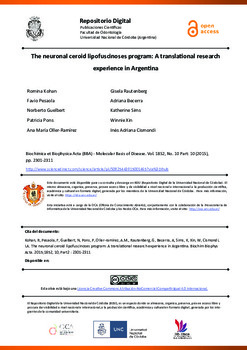| dc.contributor.author | Kohan, R. | |
| dc.contributor.author | Pesaola, F. | |
| dc.contributor.author | Guelbert, N. | |
| dc.contributor.author | Pons, P. | |
| dc.contributor.author | Oller de Ramirez, A.M. | |
| dc.contributor.author | Rautenberg, G. | |
| dc.contributor.author | Becerra, A. | |
| dc.contributor.author | Sims, K. | |
| dc.contributor.author | Xin, W. | |
| dc.contributor.author | Cismondi, I.A. | |
| dc.date.accessioned | 2017-08-14T14:20:39Z | |
| dc.date.available | 2017-08-14T14:20:39Z | |
| dc.date.issued | 2015 | |
| dc.identifier.citation | Kohan, R, Pesaola, F, Guelbert, N, Pons, P, Oller-ramírez, A.M., Rautenberg, G, Becerra, A, Sims, K, Xin, W, Cismondi, I.A. The neuronal ceroid lipofuscinoses program: A translational research experience in Argentina. Biochim Biophys Acta. 2015;1852, 10, Part2 : 2301-2311 | es |
| dc.identifier.issn | 1878-2434 | |
| dc.identifier.uri | http://hdl.handle.net/11086/4913 | |
| dc.description.abstract | Background: The Argentinean programwas initiatedmore than a decade ago as the first experience of systematic
translational research focused on NCL in Latin America. The aim was to overcome misdiagnoses and
underdiagnoses in the region.
Subjects: 216 NCL suspected individuals from 8 different countries and their direct family members.
Methods: Clinical assessment, enzyme testing, electron microscopy, and DNA screening.
Results and discussion: 1) The study confirmed NCL disease in 122 subjects. Phenotypic studies comprised
epileptic seizures and movement disorders, ophthalmology, neurophysiology, image analysis, rating scales,
enzyme testing, and electron microscopy, carried out under a consensus algorithm; 2) DNA screening and
validation of mutations in genes PPT1 (CLN1), TPP1 (CLN2), CLN3, CLN5, CLN6, MFSD8 (CLN7), and CLN8:
characterization of variant types, novel/knownmutations and polymorphisms; 3) Progress of the epidemiological
picture in Latin America; and 4) NCL-like pathology studies in progress. The Translational Research Program was
highly efficient in addressing the misdiagnosis/underdiagnosis in the NCL disorders. The study of “orphan
diseases” in a public administrated hospital should be adopted by the health systems, as it positively impacts
upon the family's quality of life, the collection of epidemiological data, and triggers research advances. This article
is part of a Special Issue entitled: “Current Research on the Neuronal Ceroid Lipofuscinoses (Batten Disease)” | es |
| dc.language.iso | eng | es |
| dc.publisher | Biochimica et Biophysica Acta (BBA) - Molecular Basis of Disease. | es |
| dc.rights | Atribución-NoComercial-CompartirIgual 4.0 Internacional | * |
| dc.rights.uri | https://creativecommons.org/licenses/by-nc-sa/4.0/deed.es | * |
| dc.subject | Neuronal ceroid-lipofuscinoses | es |
| dc.subject | Algorithms | es |
| dc.subject | Anatomy and histology | es |
| dc.subject | Enzymes | es |
| dc.title | The neuronal ceroid lipofuscinoses program: A translational research experience in Argentina | es |
| dc.title.alternative | A translational research experience in Argentina. | es |
| dc.type | article | es |
| dc.description.version | publishedVersion | es |





